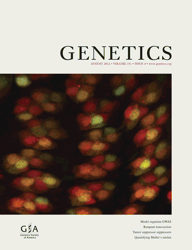Genetics:LIN-35基因可作为抗癌疗法的靶标
2012-08-13 Beyond 生物谷
通过新的涉及小线虫的实验,怀俄明州的科学家们已经发现了几个基因可能是开发抗癌症药物的潜在靶标。具体来说,研究人员推测抑制这些基因可能扭转癌细胞的某些关键特征。 拉勒米怀俄明大学分子生物学系研究员David S. Fay博士说:癌症是全球主要的死亡原因,我们希望通过开展基本的遗传研究来发现与癌症牵密切相关联的最全面的基因,以此来开发治疗多种癌症的各种治疗方法。 Fay博士和他同事利用体内存在类似
通过新的涉及小线虫的实验,怀俄明州的科学家们已经发现了几个基因可能是开发抗癌症药物的潜在靶标。具体来说,研究人员推测抑制这些基因可能扭转癌细胞的某些关键特征。
拉勒米怀俄明大学分子生物学系研究员David S. Fay博士说:癌症是全球主要的死亡原因,我们希望通过开展基本的遗传研究来发现与癌症牵密切相关联的最全面的基因,以此来开发治疗多种癌症的各种治疗方法。
Fay博士和他同事利用体内存在类似许多人癌症中灭活的基因的线虫进行研究。这各基因在蠕虫中称为LIN-35,在人身上称为PRB,该基因被认为能控制肿瘤进展的各个方面包括癌症细胞的生长和生存。研究人员系统地灭活LIN-35基因突变的蠕虫其它单个基因,当他们抑制各种基因时,科学家发现那些由于LIN-35缺失导致的缺陷能被逆转,这表明LIN-35可以作为抗癌疗法的靶标。
GENETICS期刊首席编辑Mark Johnston说:这项研究很有意义,因为它揭示了一种能关闭有助于肿瘤生长和发展的遗传机制的方法。癌症的发病原因是复杂多样的,所以我们必须从多角度来研究这种疾病。使用简单的模式生物如线虫以寻找新的药物靶标正变得日益重要。
编译自:Scientists Use Worms to Unearth Cancer Drug Targets

doi:10.1534/genetics.112.140152
PMC:
PMID:
A Network of Genes Antagonistic to the LIN-35 Retinoblastoma Protein of Caenorhabditis elegans.
S. R. G. Polley, D. S. Fay
The Caenorhabditis elegans pRb ortholog, LIN-35, functions in a wide range of cellular and developmental processes. This includes a role of LIN-35 in nutrient utilization by the intestine, which it carries out redundantly with SLR-2, a zinc-finger protein. This and other redundant functions of LIN-35 were identified in genetic screens for mutations that display synthetic phenotypes in conjunction with loss of lin-35. To explore the intestinal role of LIN-35, we conducted a genome-wide RNA-interference-feeding screen for suppressors of lin-35; slr-2 early larval arrest. Of the 26 suppressors identified, 17 fall into three functional classes: (1) ribosome biogenesis genes, (2) mitochondrial prohibitins, and (3) chromatin regulators. Further characterization indicates that different categories of suppressors act through distinct molecular mechanisms. We also tested lin-35; slr-2 suppressors, as well as suppressors of the synthetic multivulval phenotype, to determine the spectrum of lin-35-synthetic phenotypes that could be suppressed following inhibition of these genes. We identified 19 genes, most of which are evolutionarily conserved, that can suppress multiple unrelated lin-35-synthetic phenotypes. Our study reveals a network of genes broadly antagonistic to LIN-35 as well as genes specific to the role of LIN-35 in intestinal and vulval development. Suppressors of multiple lin-35 phenotypes may be candidate targets for anticancer therapies. Moreover, screening for suppressors of phenotypically distinct synthetic interactions, which share a common altered gene, may prove to be a novel and effective approach for identifying genes whose activities
作者:Beyond
版权声明:
本网站所有注明“来源:梅斯医学”或“来源:MedSci原创”的文字、图片和音视频资料,版权均属于梅斯医学所有。非经授权,任何媒体、网站或个人不得转载,授权转载时须注明“来源:梅斯医学”。其它来源的文章系转载文章,本网所有转载文章系出于传递更多信息之目的,转载内容不代表本站立场。不希望被转载的媒体或个人可与我们联系,我们将立即进行删除处理。
在此留言





#Genetics#
38
#Genet#
40
#NET#
51
#Gene#
33
#靶标#
45